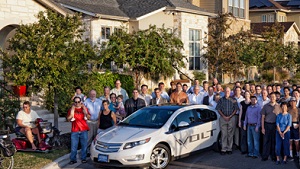Austin’s Pecan Street moves forward on solar-powered smart grid pilot
 The Pecan Street Demonstration project in Austin, Texas, which is testing a local smart grid and it’s various components in Austin’s Mueller neighborhood and near the state’s Capital, is moving forward with its second phase, which includes testing solar at 176 homes and electric vehicle (EV) car chargers at 100 residences.
The Pecan Street Demonstration project in Austin, Texas, which is testing a local smart grid and it’s various components in Austin’s Mueller neighborhood and near the state’s Capital, is moving forward with its second phase, which includes testing solar at 176 homes and electric vehicle (EV) car chargers at 100 residences.
The project is supported by a $10.4 million smart-grid demonstration grant from the Department of Energy and more than $14 million in matching funds from project partners, which include companies like Best Buy, Intel, Sony and more.
The demonstration is being coordinated by Pecan Street Inc., led by researchers from the University of Texas, National Renewable Energy Laboratory and the Environmental Defense Fund.
The homes are participating in ongoing testing of the photovoltaics as well as testing smart-appliances and other factors of the smart grid.
“What we’re working on is about 176 homes with residential rooftop PV. One hundred of those homes will also have electric cars. All but three will be Chevy Volts,” said Pecan Street Executive Director Brewster McCracken. “We also have four companies that are doing energy management control system platforms.”
The project is now in its second phase.
“We already have all the solar installed. We’re eight to nine months into the 12 month baseline phase,” he said.
And they are now beginning field trials of the energy management systems phase.
During the hottest part of the year, August, the homes with solar in the test were producing significant amounts of energy.
“Even in the month of August we found the homes with residential PV were providing 70 percent to 117 percent of their needs,” he said.
That’s before the energy management systems were put in place. As they’re installed, the systems are expected to help participants in the test save additional money and energy.
As part of the project, Pecan Street offered incentives to homeowners to install solar, but not just on the south-facing sides of the homes.
“About 60 percent of the solar is west facing,” McCracken said.
The organization offered additional incentives for installing solar on the west face of home and higher incentives for solar on both the south and west sides of homes, so the effectiveness of both could be measured.
The next step will be adding in the EVs, McCracken said.
“This is focused on residential PV and to residentially owned and operated cars and what is the most effective system architecture for that,” he said. “We’ll start getting a few in the next few months, but the bulk will arrive in June.”
At that point, homeowners can choose to charge the vehicles off their standard 120-volt outlets, like the Chevy Volt can take, or to install EV chargers.
Pecan Street may offer additional incentives or partner with a company then, if a company can make an attractive offer for a charger, McCraken said.
The project will continue to test new ways to increase energy efficiency in the home and how homes will interact with the smart grid of the future.
Image courtesy of Pecan Street.



